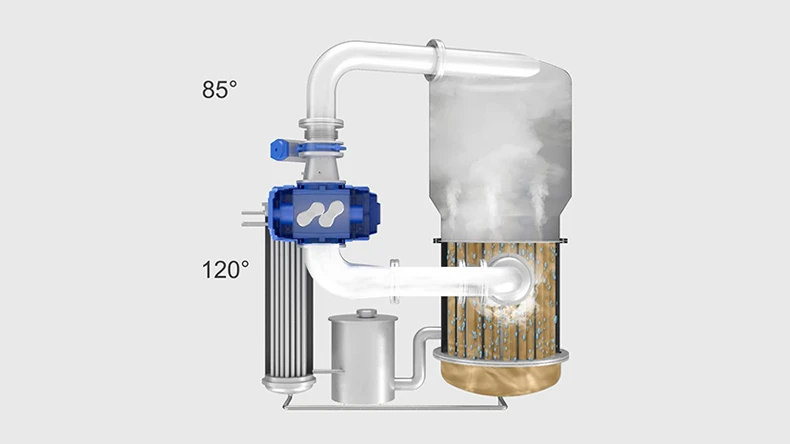Contact us
Hygiene requirements are growing increasingly strict in many sectors, and the treatment of industrial wastewater is no exception. The vacuum distillation process in particular has to deal with the question of sterile treatment and subsequent storage of water obtained from the process. The mere possibility of reintroducing wastewater into the production process makes it imperative to prevent bacterial impurities.
In many industrial production processes, for example metalworking, large quantities of wastewater are sometimes created. The presence of water can encourage rapid bacterial growth when combined with other conditions. Bacteria can be introduced with relative ease from the surrounding air, for example. To make matters worse, production halls often have high relative humidity and ambient temperatures of 25°C to 35°C. As if that weren’t enough, metalworking often involves products whose ingredients can serve as food for bacteria. These include oils, fats and waxes, which work as cofactors and rapidly accelerate bacterial growth. If bacteria spread due to these types of favourable conditions, an uncontrollable problem in production may result.
A vacuum distillation system offers a number of advantages for the treatment of industrial wastewater. In addition to drastically reducing operating and disposal costs, it also curbs bacterial growth significantly. If the wastewater is already contaminated, the treatment process can also serve as a technical barrier against the proliferation and recirculation of bacterially contaminated water. The thermal separation process serves this function during vacuum distillation. The goal is to separate the impurities from the clean water. To accomplish this, the wastewater is first heated to approximately 85°C in a vacuum during the evaporation process. The presence of saturated water vapour at a temperature of over 80°C makes survival almost impossible for most microorganisms capable of reproduction, whether bacteria, yeasts, moulds or viruses.
Once the evaporation process is complete, the water vapour is condensed at normal pressure, so that the temperature of the water vapour mixture increases again to approximately 120°C. Not even stubborn viruses and spores can survive under these conditions. The resulting distillate is therefore completely free of germs.

Main process diagram for vacuum distillation with a VACUDEST. The presence of water vapour at temperatures
of up to 120°C makes it almost impossible for even stubborn viruses and spores to survive.
Another important factor is the subsequent storage of the sterilised distillate. Tools have to be used to prevent bacterial growth at this stage as well. To accomplish this, two different procedures are recommended.
One recommended method for avoiding subsequent contamination of wastewater in storage tanks is to use biocides. This can be done using biocides that break down over time, for example Bronopol. In this way, high distillate quality can be guaranteed for long periods of time.
Another tried and proven disinfection method is to use a flow-through UV lamp. UV radiation kills off any microorganisms that may be present, thereby preventing bacterial impurities from entering the water even after distillation. One major advantage to this method is that no additional chemicals have to be used.
Industrial wastewater from metalworking processes, part cleaning systems and electroplating processes generally contains 1% to 3% impurities. Because of these impurities, the wastewater has to be disposed of at considerable cost. By treating the wastewater with the help of a vacuum distillation system, the quantities to be disposed of can be reduced considerably, thereby reducing costs. What’s more, the water recovered in the process is of such high quality that it can be reused by being reintroduced into the production process.
In seeking to reuse water, companies are often faced with the challenge of treating and storing the distillate in such a way as to completely rule out the possibility of bacterial impurities. Reintroducing contaminated wastewater would be an unmanageable problem for a company.
However, the vacuum distillation process provides customers with a reliable and clean method for treating their industrial wastewater and reusing a sterile distillate in production.
Author:
Annelie Lüth
Application engineer
H2O GmbH
You want to be part of our team and create the wastewater-free future with us?
We will tell you how!
Your contact is:
Bettina Böhringer
Human Resources
+49 7627 9239-201
career@h2o-de.com
You have questions on our VACUDEST systems?
Kindly contact us!
Your contact is:
Thomas Dotterweich
Senior Sales Engineer
+49 7627 9239-306
thomasm.dotterweich@h2o-de.com
You need consumables, spare parts or a maintenance date?
We will be pleased to assist you!
Your contact is:
Carles Fité
Technical Customer Support
+49 7627 9239-888
carles.fite@h2o-de.com